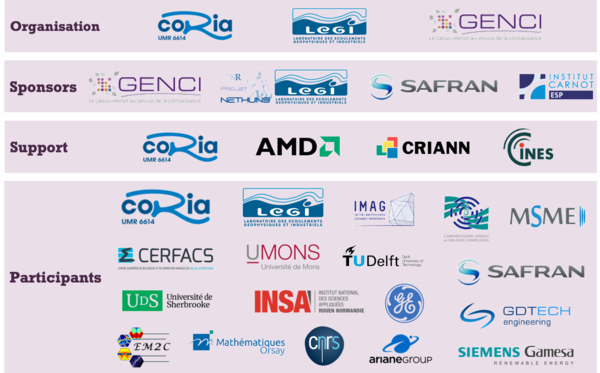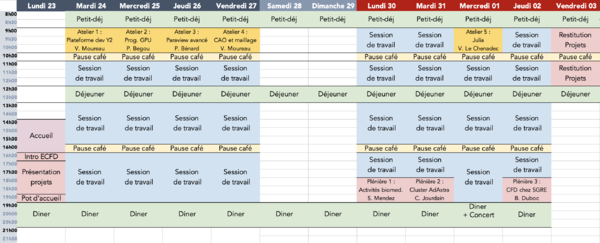ECFD workshop, 6th edition, 2022
Contents
Description
- Event from 23th of January to 3rd of February 2023
- Location: Hôtel Club de la Plage, Merville-Franceville, near Caen (14)
- Two types of sessions:
- common technical presentations: roadmaps, specific points
- mini-workshops. Potential workshops are listed below
- Free of charge
- More than 60 participants from academics, HPC center/experts and industry.
- Objectives
- Bring together experts in high-performance computing, applied mathematics and multi-physics CFDs
- Identify the technological barriers of exaflopic CFD via numerical experiments
- Identify industrial needs and challenges in high-performance computing
- Propose action plans to add to the development roadmaps of the CFD codes
Agenda
Thematics / Mini-workshops
These mini-workshops may change and cover more or less topics. This page will be adapted according to your feedback.
Projects
Hackathon - G. Staffelbach, CERFACS & P. Begou, LEGI
Mesh adaptation - R. Letournel, Safran & V. Moureau, CORIA
Numerics - S. Mendez, IMAG & M. Bernard, LEGI
- Sub-project 1: Multi-level domain decomposition method (DDM) for coupled systems of differential-algebraic equations (A. Quirós Rodrígues, V. Le Chenadec)
- Sub-project 2: Ghost fluid method (GFM) for Electrodeformation (A. Spadotto , S. Mendez)
- Sub-project 3: Optimization of the high order framework (HOF) for Navier-Stokes incompressible (M. Bernard, P. Bégou, G. Lartigue, G. Balarac)
- Sub-project 4: Force coupling method (FCM) for particulate flows (C. Raveleau, S. Mendez)
- Sub-project 5: Breaking limitations of the linearized implicit time advancement (T. Berthelon, G. Lartigue, G. Balarac)
- Sub-project 6: Development of a traction open boundary condition (TOBC) in Yales2 (J.B. Lagaert, Guillaume Balarac)
- Sub-project 7: Development of new differential operators in Yales2 (M. Bernard, G. Lartigue)
- Sub-project 8: DOROTHY optimization (M. Roperch, H. Mulakaloori, G. Pinon, P. Bénard)
- Sub-project 9: Anamika, a tool to improve programming productivity (K. Mohana Muraly, G. Staffelbach)
Turbulence - P. Benard, CORIA & G. Balarac, LEGI
- Sub-project 1: Explore hybrid RANS/LES strategies (T. Berthelon, G. Balarac)
For complex industrial applications, LES can still lead to a too long restitution time. In other hand, statistical approaches can lead too a lack of accuracy. In this project, the potentiality of hybrid approaches combining both have been explored. Conventional hybrid RA?S/LES approaches consider a unique solution field, with an unique transport equation and a clusre terme modeled using RANS or LES models depending of the regions. The main idea is to evaluate a strategy based on a separation between mean fields and fluctuations with distinct coupled transport equations. First elements of validation using YALES2 code are shown that it was possible to correct the prediction of a RANS models, by performing LES of the fluctuations. Next steps should be to consider disctinct meshes, or even computational domains for RANS and LES with this strategy.
- Sub-project 2: Flow Instabilities over Rotating curved Surfaces (S. Sawaf, M. Shadloo, A. Hadjadj, S. Moreau, S. Poncet)
For evaluating the effect of the clearance between the blade tip and the casing of axial ducted fans on noise emissions, LES offers excellent tool to capture the consitricted flow around the blade tip especially for small clearances where RANS fails because of unsteady flow conditions. LES simulation of the aerodynamics is the first step toward extracting accoustics data that helps to improve the design of axial ducted fans so they comply with the noise emission regulations in admistrative buildings. noise emmisions are estimated using analytical aeroacoustic models informed by data that are extracted from the LES simulations.
- Sub-project 3: Automatic statistical convergence metric (C. Papagiannis, G. Balarac, O. Le Maitre, P. Congedo)
Statistics accumulation can be an important part of the restitution time in unsteady simulations (DNS/LES). In this project, the goal was to estimate uncertainties on the "finite time statistics". For time correlated data, it can be shown that the variance of the mean estimator (i.e. the fluctuation of the estimation of the mean) is dependent of the correlation time. Modeling this correlation time based on the integral time scale of the turbulence appears as a first way to define a practical metric to evaluate the statistic convergence on-fly during simulations. Next step should be to explore procedures to accelerate the statistics accumulation step.
- Sub-project 4: Wall law for Immersed Boundaries & Rough surfaces (M. Cailler, A. Cuffaro, P. Benez, S. Meynet)
Conservative Lagrangian Immersed Boundaries (CLIB) are now an useful way to take into account complex geometries in YALES2. During the workshop, a brand-new data-structure for modular and generic immersed-body has been developed. This data-structure paves the way for various new capabilities for IB methods: penalization mask shape optimization for improved velocity imposition, better control of near wall discretization based on a reliable evaluation of wall units, wall-modeling, etc... For this purpose the periodic hill test case has been considered. Simulations of this configuration has been performed by using body-fitted meshes, and CLIB for both smooth and rough surfaces. This will allow to assess the accuracy of the IB methods, and will constitute a database for IB models improvement, and the development of wall-modeling strategies.



